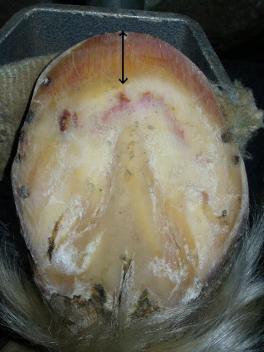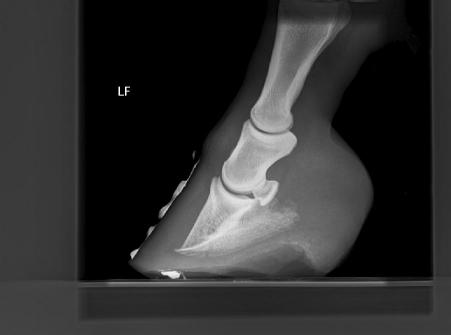Beckie’s Equine Letter
News, Case Studies, Questions & Answers
and a Lesson of the Month in every Issue
Spring 2006 — Issue 10
News for the Month
Welcome to my Spring newsletter, a time to be happy as we’re coming into good weather and the season for all the events is on its way. I’m going to cover a variety of things in this newsletter, but with the spring grass coming through I do want to bring Laminitis to the fore front of your minds. In this months case study I’ll be sharing with you an exciting trim I did on a chronic Laminitic at Liphook.
I’ve been to a couple of seminars since my last newsletter. One was at Bell Equine in Kent, this was discussing the use of MRI scanning. MRI’s are a collection of photographs taken through the limb, sliced at just a few millimetre intervals so you can see right through the leg. They are taken at three different angles so you end up with about 45 separate pictures. The equipment used is very expensive and it takes quite a lot of people to get a set of pictures. This makes it very expensive, around £1000 to have this done, but it is the most accurate and up to date method for diagnosing lameness. The second talk was by Andy Crawford one of Arundel’s vets. He was discussing what it is like working with Racing yards. It became a good discussion with around 30 farrier’s. My conclusion from the evening is I definitely don’t want to shoe race horses, and value you as customers even more.
Strangles seems to be an increasing problem so I thought I should explain where I stand on the subject. Strangles is an extremely contagious disease, and if there is a yard diagnosed with this disease I will not be attending the yard until the vet gives me the all clear and the incubation period is over. Even if your horse doesn’t have strangles but others on the yard do, it’s too high a risk for me to take coming onto the yard. Even if I took all precautions, disinfecting all my tools and changing my clothes I would never forgive myself if another yard did come down with it. And even if it was nothing to do with me people will want to blame someone and I don’t want to take that risk. You may see other farrier’s coming on to the yard, that is their choice, but please have in your mind that I am not coming out of respect for my other customers. And as this is a problem that will show it’s face regularly, I’m sure you’ll appreciate me taking these precautions to protect all your horses.
In my last newsletter Hazel Blake, a local Physiotherapist, wrote the Lesson of the Month and also included a coupon with a special introductory offer. I’m pleased to say quite a few people took advantage of this great offer. Hazel has seen a few horses from my client base now, and has had some really great results. I think it is so important that we look at the whole horse when we are trying to help them perform. And physiotherapy is definitely another essential tool to enable us to get the best out of our horses.
Lesson of the Month
What Happens with Laminitis
In issue 7 I went over some of the signs and causes of Laminitis, to continue on, today I’m going to explain some of what actually goes on within the foot when a horse gets Laminitis. I’m going to cover some of the external signs you can see and relate them to what is going on internally.
One of the visible things that you can see with Laminitis is the stretching of the white line on the ground surface of the foot. As shown below.

This is where the bond between the pedal bone and the hoof wall has become starved of blood and begins to haemorrhage and die. This is obviously pretty serious as the pedal bone is supported and held in place by the laminae. (The connecting structure between the wall and the pedal bone.) If the laminae becomes really unstable the pedal bone is at risk of dropping or rotating within the hoof capsule.
Another thing that happens is accelerated foot growth. The feet are quite incredible—they will regenerate foot as fast as possible to speed up recovery. Because the pain is primarily in the toe region, the heels of the hoof will grow faster to give the horse a firm platform to walk on. Also as the new foot grows down you often see growth rings forming around the foot. This is showing the new foot growing down from the coronary band. There is often a change in the angle of the wall at this point where the wall is stretching away from the pedal bone. This needs to be regularly rasped back to not cause a levering affect on the wall.
Here are a couple of diagrams showing a laminitic foot from the side compared to a healthy trimmed foot.
This is shown quite clearly on the x-rays in my case study.
I hope by going over some of the external signs and relating it to what is going on internally within the foot, it will help you to understand what you are seeing.
Top Tip
Remember, the Fructans (sugars) in the grass that can trigger Laminitis are higher first thing in the morning, especially when dew is on the grass or after a heavy frost. So if you want to take extra precautions towards Laminitis I advise you to keep your horse stabled between 6am and 11am or there about’s.
Case Study
Laminitic Trim at Liphook Veterinary Hospital
This case study is showing a 10hh pony that came in at Liphook very sore on it’s feet with Chronic Laminitis. The owner said her farrier had trimmed her pony just four days ago, but she didn’t think he cut much off!
When working at the vets we are very fortunate to be able to have x-rays taken at every stage so you can determine accurately how much foot to take off and at what angle the pedal bone is in. So with this pony we had x-rays taken before and after the trim.
These first two pictures show the left front. You can see how the front wall has completely torn away from the pedal bone and the pedal bone is now tipped down. The heels are also very long and the pony is in quite a lot of trouble.

Now these pictures that follow are the same foot after just one trim. You can now see the front wall is running in a straight line down from the coronary band. There is also a similar wall thickness, rather than before the toe was really stretched and extended. To me the most amazing thing is that the Hoof Pastern axis (the angle of the bones below the fetlock) is now aligned. This has been achieved with taking the heels down.
This pony was so much happy straight away after this quite extreme trim. The pony will take time to adjust to the new angles of it’s leg, but all the tearing forces on the pedal bone have now gone. And he should remain much more comfortable. It just shows what can be achieved with trimming.

Feedback
Today’s feedback follows on from my last issue when I took the hind shoes off Carol Stanley’s horse Teddy. I have chosen to use the whole of the back page as I thought this was an interesting one for all of us to learn from.
So here is Carol’s report on how Teddy has been adjusting to being barefoot behind:
Friday 13th January the hind shoes were taken off.
Teddy was worked Friday in the sand school, and went out for a short ride on Saturday. He was sore when on the concrete but happy on grass.
We rested him from Sunday to Wednesday and gave him some Bute.
Teddy then had two days being ridden in the sand school, then a short ride out sticking to the grass on Saturday. He was much happier but still resting his feet when he was stood on the concrete yard.
Week 3 much happier.
Week 4 getting better.
Week 5 he was ridden four times and taken on the road, he still favoured the grass but was ok.
Teddy was re-shod at the end of week 5 still just with front shoes.
Teddy was sore for the first two weeks especially on the concrete he would lift one leg and then the other to rest his feet. My daughter Sophie put a towel down under his hind feet to give him something soft to stand on which he preferred. We also put Keratex Hoof hardener on every day. Things didn’t improve significantly over the next few weeks. I began to wonder what I had done as he could only go out on the grass which restricted the rides. But then by week four he seemed to be better not resting his hind feet in the yard and happier when out. By week five we took him out for his first ride along the road and up the downs. He favoured the grass verge where possible, but was full of life on the top of the downs and on the grass. He was ridden a lot more the fifth week. Then on the Friday Beckie re-shod his front feet and just very lightly shaped up his hinds taking nothing off the bottom. When Beckie arrived she thought his hind feet were quiet broken up, I wasn’t too surprised as Beckie said this would happen. He was very awkward for Beckie to shoe, as when she had a front foot in the air he obviously had to put more weight on his hinds and he protested. Beckie was concerned and said if he was no better in the coming weeks she felt we should put shoes back on. He seemed ok at first, but when we came to ride him he was back to being sore again, and resting his hind feet in the yard. I was very concerned, unfortunately it seemed to be a step backwards. He was ridden out, but we avoided the road. I am going to give it a couple of weeks but I don't think he’s going to adapt I think we’ll have to put shoes back on sooner than the next appointment.
Carol Stanley
Conclusion- Carol was very patient giving Teddy time to adapt, but this just proves that not all horses are able to go without shoes, when asked to do the jobs that we want them to do. Teddy now has hind shoes back on and is raring to go :-)